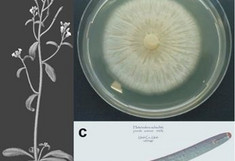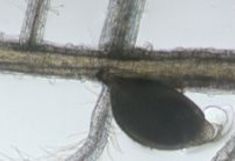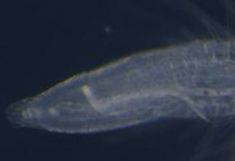Research highlights
Sedentary plant-parasitic nematodes – hidden pests of crop plants
Sedentary cyst- and root-knot nematodes belong to the most devastating pests in agriculture worldwide. These parasites withdraw all nutrients required for their development and reproduction from sophisticated feeding sites induced in root tissue. Those structures are responsible for the massive redirection of the required nutrients in the host tissues what results in growth impairment as well as yield reduction causing huge economic losses. Once these pests have established in the field, sedentary plant-parasitic nematodes are difficult to deal with. Physical sanitation is costly and time-intensive, chemical control measures usually affect non-target organisms.
Additionally, many nematode species are polyphagous, being able to parasitize roots of many different plant species. The host plant symptoms are mostly unspecific and therefore farmers often overlook or underestimate the infestation level in the field. Accordingly, it is necessary to prevent or at least reduce the spread of plant-parasitic nematodes as much as possible following the standard hygiene practices. Furthermore, the use of resistant/tolerant plants or non-host plants during crop rotation is of utmost importance.
As an alternative, Krzysztof Wieczorek and his colleagues from the Institute of Plant Protection at BOKU investigate a root-endophytic fungus as an alternative biological control against sedentary plant-parasitic nematodes. The aims of the project are to understand the interactions between the fungus, host plant and the nematodes on a molecular level. The obtained results could help in the development of a biological and sustainable method for nematode control. This project is financed by the FWF and obtained results will be published 2020/2021 in international peer-reviewed journals.
Predator-prey relationships under thermal stress: does prey more profit from plastic modifications than the predator?
Title of the project: Heat wave effects on an acarine predator-prey relationship
Program: individual project of FWF Austrian Science Fund
Project management: Institute of Plant Protection, BOKU
Contact person: Mag. Dr. Andreas Walzer
The intensity, duration and frequency of heat waves should increase in the next years because of climate warming. Organisms, however, can cope with heat stress by plastic modifications to a certain extent. But what happens when a predator and its prey have different plastic adaptation potentials? Does it lead to the decoupling of the finely tuned predator-prey interaction? These questions are investigated by using the predatory mite Phytoseiulus persimilis and its prey, the spider mite Tetranychus urticae as study objects, which have prominent roles in biological control.





